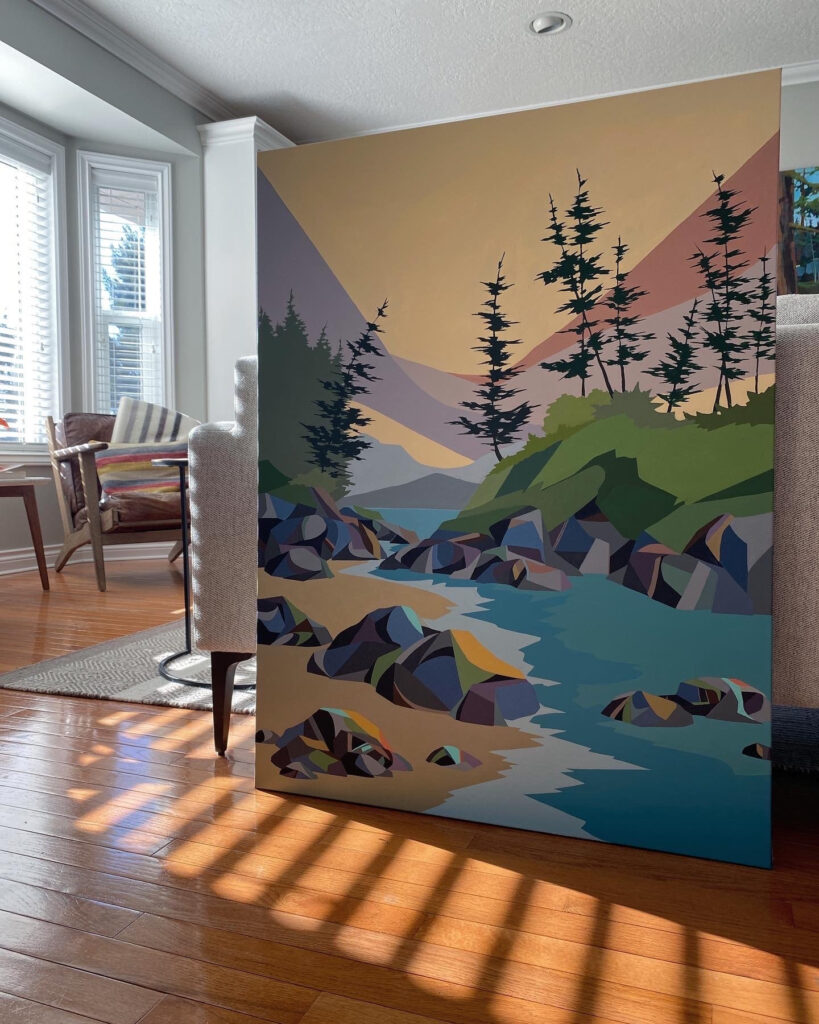I often hear artists talking about their desire in creating bigger paintings, myself included. I have always felt like a bigger painting means more freedom, more impact, and a bigger challenge.
And if you think the same, this article is for you!
Why does everyone love large-scale art?
Artists aren’t the only ones obsessed with the idea of creating bigger artworks. Large-scale art offers a better immersive experience to the viewers as well. A bigger surface gives so much space for creativity, for different subjects to take space, and for the painting to be more of an experience than a work of art.
By now, you know how obsessed I am with older aesthetics. Michelangelo, Rembrandt, Monet, Klimt, Botticelli, and many other art masters have created massive paintings, ceilings, and walls that depicted scenes from history, either real or mythic. And these gigantic artworks somehow impacted me as a viewer more than other smaller paintings ever did.
Does it mean that smaller paintings aren’t good enough?
As a painter myself, I like both. I think smaller artworks serve a purpose different than bigger paintings. When painting on a small scale, you have a lot of control over your work. You can see the whole of it even if you are working closely on details. Therefore, your chances of making mistakes are fewer compared to bigger paintings. It is also so much more convenient to work on a smaller scale because you can make changes as you go and it doesn’t consume much of your time.
For an absolute beginner, I highly recommend you stick to smaller surfaces as you can practice and experiment often at no high cost (both money and time). Even as a beginner, if you are willing to figure out your art style, certainly give bigger surfaces a try.
When to paint large-scale art?
1- When you are comfortable with your medium
Creating big paintings requires adopting slightly different working methods than when you work with a small canvas. Therefore, it would be more convenient for you to use a medium that you are pretty comfortable with so you can leave the challenge of adapting your techniques to your surface.
2- You are confident in your color mixing abilities
If you are painting from a reference, you need to pay big attention to the work of color. When you scale up an image everything becomes exaggerated. The same color ratio you would normally go for in a smaller piece will look way more bright and loud once it is painted on a bigger surface.
3- When you are ready to work with bigger brushes
Use rollers for your base instead of brushes. Just as you have to be aware of scaling down your color choices and scaling up the volume of paint, you have to use larger tools to apply the paint too.
4- When you are ready to invest the time a bigger piece needs
Although you may think that using larger tools will save you time, creating big paintings does require a lot of time. Those who paint to practice or film content will find it very challenging as the process of creating big paintings isn’t fast rewarding and requires a lot more dedication and attention.
5- You have enough patience to take breaks and start over
You will mess up parts of your painting and it will be very annoying to go over them as the time and energy you put into the work is a lot. But if you want to create big paintings that steal the show, you will need to have the same patience that the old masters had. Be ready to take breaks, go for walks, have some tea or coffee, and then come back with fresh eyes to fix your errors and improve your work of art.
Read this: What to do when you mess up a Painting? The artist’s fear of imperfection
Tips for creating big paintings
- A first tip would be to begin drawing out your painting in a smaller size (I do an A5 or an A4 in my sketchbooks). Plan out the painting, figure out colors, and then enlarge it. You can also use a grid if needed! Using a grid is the best way to ensure the proper proportions of your piece. Split your sketch into grid squares in proportion to the canvas. Then you should replicate the squares from your drawing into corresponding squares on the canvas. (You can see that I use grids for my paintings as well in this pin)
- I know most artists are painting in their living room, kitchen, or bedroom. But when creating a big painting, you will need a lot of space in your room. You will need to continuously step a few feet back to see your mistakes and what needs to be touched up.
- If you are mixing colors, make sure you mix enough before you start. Trust me, you won’t be able to match it perfectly later.
- Large canvases can be expensive. Be on the lookout for sales. When there is a 50-70% off sale, stock up on the larger canvases while they are cheap! You’ll be thanking yourself later.
Conclusion
Go for it, stop dreaming about those large paintings. Although creating big paintings can be really intimidating, the learning process is very rewarding and will be worth it. Enjoy creating <3




1 Comment